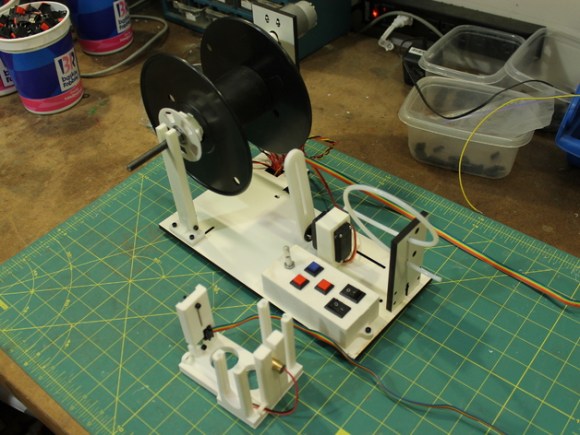
The latest addition to the line of 3D printer accessories is the FilaWinder, a tool for winding your filament neatly onto a spool. If you’ve abandoned buying your filament by the reel in favor of making your own from cheaper pellets—such as the Lyman Extruder, the Filabot Wee, or other alternatives, including the winder’s companion product, the FilaStruder—then you’ve likely had to roll everything up by hand, perhaps after it flopped around on the floor first.
The FilaWinder spools for you while the filament extrudes, using a sensor to adjust the winding the speed to match extrusion rates as well as running it through some PTFE tube to gently coil it as it moves along. Perhaps most important, the FilaWinder provides a guide arm to direct the filament back and forth across the reel as it spools up, to keep it evenly distributed. Swing by their Thingaverse page for a list of printable pieces and their assembly guide can be found here, as well as on YouTube. You can see an overview video of the FilaWinder winding away after the break.
[Thanks David]
















$160 sounds expensive for this, but maybe a DIY version would be cheaper. The BOM excel file on the ThingiVerse page lists the parts cost as $136, plus $57 shipping. All of the pieces are $2 or less except the Arduino Nano clone ($10), controller PCB ($24), sensor PCB ($8), PSU ($9), motor ($9), servo ($12), laser ($9), PTFE tubing ($5 and $3), and threaded rod ($3).
It should be possible to run this off of spare pins on RepRap controller. The PSU could also be shared with the FilaStruder or printer. The servo filament guide wouldn’t be necessary if the PTFE tensioner was far enough from the reel. I like that he lets makers save a few bucks by printing their own FilaStruder hopper, but he doesn’t offer options like this for the FilaWinder printed/laser cut parts. Does anyone have other cost-cutting ideas?
Full disclosure – Tim here, the guy behind the FIlastruder. Ian made the Fila Winder.
A fair chunk of the $160 is in the small run PCB/PCBA. People think electronics are cheap – that’s true, if you can keep the volume up.
An electronics only version is in the works, but we wanted to gauge demand first with the whole kit before trying to manage various inventory (it is easier to buy/make/kit 50 of everything at a time instead of trying to guess how much of each is needed)
Finally, you definitely need the servo guide. Even with the PTFE loop far away, the filament will not lay itself neatly without a guide. Look at the pro extruders for more info on this.
Hmmm… or we could do it for $60 ish… the semi analog way…
http://southchathamtackle.com/store/store.php?crn=209&rn=427&action=show_detail
it would need a motor…they suggested a drill. Seems like if you used a variable speed drill and used the line tension vary the drill speed, you’d be done, but I haven’t seen one of these extruder jobbies run before.
I wonder if you could find a salt water respooler on Ebay for less. I pick saltwater because the reels look like a similar diameter.
You definitely need closed loop control. The filament tension needs to be sensed very precisely, and the best way to do this is constant force (gravity), which means sensing filament position. Winding is the easy part… but you must have closed loop control.
Does anyone know what sensor is used for the kit. As in the make and model
What laser receiver or detector is used ? As in the one that in connected to the rainbow cord.